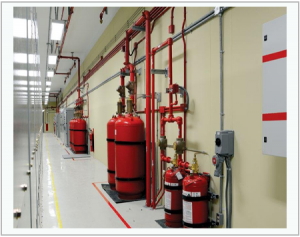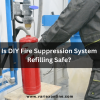![]()
Fire Immuniser
+91-7829629111
Email: info@variex.in
Varistor Technologies Pvt. Ltd.
Block-1, First Floor, Ardente Office One, Hoodi Circle, ITPL Main Road, Bengaluru, Karnataka 560048, IN
How Are Fire Suppression Systems Installed?
Fire suppression systems are critical components of building safety, designed to detect and extinguish fires swiftly, minimizing damage and protecting lives. Installing these systems requires careful planning, precise execution, and adherence to strict regulations. Here's a comprehensive overview of the process involved in installing fire suppression systems. 
1. Assessment and Planning:
- The installation process begins with a thorough assessment of the building's layout, occupancy, and fire risks. This assessment helps determine the type of fire suppression system needed and the areas it should cover.
- Engineers develop a customized fire safety plan based on the assessment findings, identifying the optimal placement of suppression equipment, such as sprinklers, nozzles, and extinguishing agents.
2. Equipment Selection:
- Once the fire safety plan is finalized, appropriate suppression equipment is selected based on factors such as building size, occupancy type, and fire hazards present.
- Different types of fire suppression systems may be considered, including wet pipe sprinkler systems, dry pipe sprinkler systems, pre-action systems, gaseous suppression systems, and foam systems, depending on the specific requirements of the building.
3. Installation and Integration:
- Qualified technicians install the selected suppression equipment according to approved designs and manufacturer specifications. Installation involves mounting sprinklers, piping, and control panels in designated locations throughout the building.
- The suppression system is integrated with other building systems, such as fire detection systems, alarm systems, and building automation systems, to ensure seamless operation and coordination during emergencies.
4. Testing and Commissioning:
- Following installation, rigorous testing and commissioning procedures are conducted to verify the functionality and effectiveness of the suppression system.
- This includes testing individual components, such as sprinkler heads and control valves, as well as conducting full-system tests to simulate fire scenarios and assess the system's response.
5. Training and Maintenance:
- Occupants and building staff receive training on the operation and maintenance of the suppression system. This includes familiarizing them with system components, emergency procedures, and proper maintenance practices.
- Regular maintenance schedules are established to ensure the ongoing reliability of the suppression system. This may include periodic inspections, testing, and servicing conducted by certified professionals to address any issues and ensure compliance with regulations.
6. Regulatory Compliance:
- Throughout the installation process, strict adherence to building codes, regulations, and industry standards is essential. Compliance with these requirements ensures that the suppression system meets minimum safety standards and reduces the risk of penalties or liabilities.
In conclusion, the installation of fire suppression systems is a complex but crucial process in enhancing building safety and protecting against fire hazards. By following a systematic approach, involving assessment, planning, equipment selection, installation, testing, and maintenance, building owners can ensure the effective deployment of suppression systems tailored to their specific needs and regulatory requirements.
Frequently Asked Questions
Fire suppression systems are specialized equipment designed to detect and extinguish fires automatically or manually. They are essential for protecting buildings, occupants, and assets by rapidly containing and suppressing fires, minimizing damage and loss.
Common types of fire suppression systems include sprinkler systems, gaseous suppression systems (e.g., CO2, FM-200), foam systems, and water mist systems. Each type is tailored to specific fire risks, building layouts, and environmental factors.
Fire suppression systems are typically installed by qualified technicians who have received specialized training and certification in fire protection engineering or related fields. These professionals possess the knowledge and skills to ensure the proper design, installation, and maintenance of suppression systems.
The need for a fire suppression system is determined through a comprehensive risk assessment conducted by fire safety experts. Factors such as building occupancy, fire hazards, regulatory requirements, and insurance mandates are considered in assessing the need for suppression systems.
The installation process typically includes preliminary assessment, design and planning, equipment selection, installation of suppression equipment (e.g., sprinklers, piping), integration with building systems, testing and commissioning, and training of occupants and staff.
Final Say
We at VariEx.in or Variexonline.com have mastered the art of designing, installing, inspecting, and fixing automatic sprinkler systems with the help of our in-house team, which is capable of delivering the fire sprinkler services you need, whether large or small and at affordable cost.
To schedule a fire sprinkler installation, or you think our services could benefit your commercial property, contact us online or give us a call at, 7829629111









